Effect of Vegetation Restoration on Soil Hydrology in Karst Area of Southwest China: Inspiration from Barrel Planting Experiments
Abstract
:1. Introduction
2. Materials and Methods
2.1. Study Area
2.2. Experimental Design
2.3. Analytical Method
- (1)
- Soil water storage [24]. Soil water storage refers to θ within a certain depth range. The soil water storage was calculated using Equation (1):
- (2)
- The soil water replenishment was calculated using Equation (2):
- (3)
- The lag time at each rainfall event was calculated using Equation (3):
- (4)
- The rainfall replenishment rate to soil water was calculated by using Equation (4):
- (5)
- The rainfall replenishment efficiency to soil water was calculated by using Equation (5):
- (6)
- Soil water potential gradient [25]. The water potential gradient is equal to the ratio of the difference in between two points and the distance between two points. The water potential gradient was calculated by using Equation (6):
2.4. Statistical Analysis
3. Results
3.1. Dynamic Changes in Profile θ
3.2. The Hysteresis of θ during Typical Rainfall
3.3. Effective Replenishment of θ during Typical Rainfall
3.4. Dynamic Changes in Soil Moisture Storage
3.5. Dynamic Change of
3.6. Temporal Variation in Moisture Potential Gradient
4. Discussion
4.1. Variations in θ for the Four Vegetation Types
4.2. Rainfall Response of Soil Moisture
4.3. Soil Water Stress of Different Vegetation Types
5. Conclusions
Author Contributions
Funding
Institutional Review Board Statement
Informed Consent Statement
Data Availability Statement
Acknowledgments
Conflicts of Interest
References
- Yang, J.; Chen, H.; Nie, Y.; Wang, K. Dynamic variations in profile soil water on karst hillslopes in Southwest China. Catena 2019, 172, 655–663. [Google Scholar] [CrossRef]
- Chen, H.; Zhang, W.; Wang, K.; Fu, W. Soil moisture dynamics under different land uses on karst hillslope in northwest Guangxi, China. Environ. Earth Sci. 2010, 61, 1105–1111. [Google Scholar] [CrossRef]
- Yang, L.; Chen, L.D.; Wei, W.; Yu, Y.; Zhang, H.D. Comparison of deep soil moisture in two re-vegetation watersheds in semi-arid regions. J. Hydrol. 2014, 513, 314–321. [Google Scholar] [CrossRef]
- Jia, Y.-H.; Shao, M.-A. Temporal stability of soil water storage under four types of revegetation on the northern Loess Plateau of China. Agric. Water Manag. 2013, 117, 33–42. [Google Scholar] [CrossRef]
- Chen, H.S.; Hu, K.; Nie, Y.P.; Wang, K.L. Analysis of soil water movement inside a footslope and a depression in a karst catchment, Southwest China. Sci. Rep. 2017, 7, 2544. [Google Scholar] [CrossRef] [PubMed] [Green Version]
- Canton, Y.; Rodríguez-Caballero, E.; Contreras, S.; Villagarcia, L.; Li, X.-Y.; Solé-Benet, A.; Domingo, F. Vertical and lateral soil moisture patterns on a Mediterranean karst hillslope. J. Hydrol. Hydromech. 2016, 64, 209–217. [Google Scholar] [CrossRef] [Green Version]
- Daly, E.; Porporato, A. A Review of Soil Moisture Dynamics: From Rainfall Infiltration to Ecosystem Response. Environ. Eng. Sci. 2005, 22, 9–24. [Google Scholar] [CrossRef]
- Heathman, G.C.; Cosh, M.H.; Merwade, V.; Han, E. Multi-scale temporal stability analysis of surface and subsurface soil moisture within the Upper Cedar Creek Watershed, Indiana. Catena 2012, 95, 91–103. [Google Scholar] [CrossRef]
- Huang, X.; Shi, Z.H.; Zhu, H.D.; Zhang, H.Y.; Ai, L.; Yin, W. Soil moisture dynamics within soil profiles and associated en-vironmental controls. Catena 2016, 136, 189–196. [Google Scholar] [CrossRef]
- Yang, L.; Wei, W.; Chen, L.; Jia, F.; Mo, B. Spatial variations of shallow and deep soil moisture in the semi-arid Loess Plateau, China. Hydrol. Earth Syst. Sci. 2012, 16, 3199–3217. [Google Scholar] [CrossRef] [Green Version]
- Das, N.N.; Mohanty, B.P.; Njoku, E.G. Profile Soil Moisture across Spatial Scales under Different Hydroclimatic Condi-tions. Soil Sci. 2010, 175, 315–319. [Google Scholar] [CrossRef] [Green Version]
- Brocca, L.; Morbidelli, R.; Melone, F.; Moramarco, T. Soil moisture spatial variability in experimental areas of central Italy. J. Hydrol. 2007, 333, 356–373. [Google Scholar] [CrossRef]
- Williams, P.W. The role of the epikarst in karst and cave hydrogeology: A review. Int. J. Speleol. 2008, 37, 1–10. [Google Scholar] [CrossRef] [Green Version]
- Tokumoto, I.; Heilman, J.L.; Schwinning, S.; McInnes, K.J.; Litvak, M.E.; Morgan, C.L.S.; Kamps, R.H. Small-scale variability in water storage and plant available water in shallow, rocky soils. Plant Soil 2014, 385, 193–204. [Google Scholar] [CrossRef]
- Nie, Y.-P.; Chen, H.-S.; Wang, K.-L.; Tan, W.; Deng, P.-Y.; Yang, J. Seasonal water use patterns of woody species growing on the continuous dolostone outcrops and nearby thin soils in subtropical China. Plant Soil 2011, 341, 399–412. [Google Scholar] [CrossRef]
- Bonacci, O.; Pipan, T.; Culver, D.C. A framework for karst ecohydrology. Environ. Earth Sci. 2008, 56, 891–900. [Google Scholar] [CrossRef]
- Peng, T.; Wang, S.-J. Effects of land use, land cover and rainfall regimes on the surface runoff and soil loss on karst slopes in southwest China. Catena 2012, 90, 53–62. [Google Scholar] [CrossRef]
- Xiong, K.N.; LI, J.; Long, M.Z. Features of Soil and Water Loss and Key Issues in Demonstration Areas for Combating Karst Rocky Desertification. Acta Geogr. Sin. 2012, 67, 878–888. [Google Scholar]
- Yuan, D.X. World correlation of karst ecosystem: Objectives and implementation plan. Adv. Earth Sci. 2001, 4, 461–466. [Google Scholar]
- Chen, H.S.; Nie, Y.P.; Wang, K.L. Spatio-temporal heterogeneity of water and plant adaptation mechanisms in karst regions: A review. Acta Ecol. Sin. 2013, 33, 317–326. [Google Scholar] [CrossRef] [Green Version]
- Peng, J.; Yang, M.D. On the Present Soil Erosion Situation of Huajiang Karst Gorge in Guizhou Province. J. Mt. Sci. 2001, 6, 511–515. [Google Scholar]
- Xiong, K.N.; Chi, Y.K. The Problems in Southern China Karst Ecosystem in Southern of China and Its Countermeasures. Ecol. Econ. 2015, 31, 23–30. [Google Scholar]
- Fu, T.G.; Chen, H.S.; Zhang, W.; Nie, Y.P.; Peng, T.; Wang, K.L. Spatial variability of surface soil saturated hydraulic con-ductivity in a small karst catchment of southwest China. Environ. Earth Sci. 2015, 74, 2381–2391. [Google Scholar] [CrossRef]
- Yang, L.; Zhang, H.; Chen, L. Identification on threshold and efficiency of rainfall replenishment to soil water in semi-arid loess hilly areas. Sci. China Earth Sci. 2018, 61, 292–301. [Google Scholar] [CrossRef]
- Jing, B.D.; Jin, G.H.; Min, L.L.; Shen, Y.J. Deep soil moisture dynamic of typical irrigation farmland in piedmont of Taihang mountain. Trans. Chin. Soc. Agric. Eng. 2015, 31, 128–134. [Google Scholar]
- Zhang, C.; Chen, H.S.; Nie, Y.P.; Zhang, W.; Feng, T.; Wang, K.L. Dynamics of soil profile water content in peak-cluster de-pression areas in karst region. Chin. J. Eco-Agric. 2013, 21, 1225–1232. [Google Scholar] [CrossRef]
- Lei, Z.D.; Yang, S.X.; Ni, G.H. Water continuum feature in response to the type of groundwater level. J. Hydraul. Eng. 1992, 2, 1–6. [Google Scholar]
- Cai, L.L.; Liu, Z.Q.; LI, Y.; Yu, X.; Jing, J.S. Effect of Different Land Use Types on Soil Saturated Hydraulic Conductivity in Karst Areas. Res. Soil Water Conserv. 2020, 27, 119–125. [Google Scholar]
- Wang, X.Y.; Chen, H.S.; Wang, K.L.; Xie, X.L. Spatio-Temporal Dynamic Change of Soil Water in Sloping Land with Differ-ent Use Modes in Red Soil Region. J. Soil Water Conserv. 2006, 2, 110–113. [Google Scholar]
- Fu, W.; Chen, H.S.; Wang, K.L. Variability in soil moisture under five land use types in Karst hillslope territory. Chin. J. Eco-Agric. 2007, 15, 59–62. [Google Scholar]
- Nie, Y.-P.; Chen, H.-S.; Wang, K.-L.; Ding, Y.-L. Rooting characteristics of two widely distributed woody plant species growing in different karst habitats of southwest China. Plant Ecol. 2014, 215, 1099–1109. [Google Scholar] [CrossRef]
- Rong, L.; Xiong, K.N. Drought-resistance characters of karst plant of adaptability in Huajiang karst gorge: Root system of Zanthoxylum planispinum var dintanensis and its soil environment. J. Guizhou Norm. Univ. 2007, 4, 1–7. [Google Scholar]
- Heisler-White, J.L.; Knapp, A.K.; Kelly, E.F. Increasing precipitation event size increases aboveground net primary produc-tivity in a semi-arid grassland. Oecologia 2008, 158, 129–140. [Google Scholar] [CrossRef] [PubMed]
- Kurc, S.A.; Small, E.E. Soil moisture variations and ecosystem-scale fluxes of water and carbon in semiarid grassland and shrubland. Water Resour. Res. 2007, 43. [Google Scholar] [CrossRef]
- Yaseef, N.R.; Yakir, D.; Rotenberg, E.; Schiller, G.; Cohen, S. Ecohydrology of a semi-arid forest: Partitioning among water balance components and its implications for predicted precipitation changes. Ecohydrology 2009, 3, 143–154. [Google Scholar] [CrossRef]
- He, Z.; Zhao, W.; Liu, H.; Chang, X. The response of soil moisture to rainfall event size in subalpine grassland and meadows in a semi-arid mountain range: A case study in northwestern China’s Qilian Mountains. J. Hydrol. 2012, 420-421, 183–190. [Google Scholar] [CrossRef]
- Wythers, K.R.; Lauenroth, W.K.; Paruelo, J.M. Bare-Soil Evaporation under Semiarid Field Conditions. Soil Sci. Soc. Am. J. 1999, 63, 1341–1349. [Google Scholar] [CrossRef]
- Yao, X.; Fu, B.; Lü, Y.; Chang, R.; Wang, S.; Wang, Y.; Su, C. The multi-scale spatial variance of soil moisture in the semi-arid Loess Plateau of China. J. Soils Sediments 2012, 12, 694–703. [Google Scholar] [CrossRef]
- Zhao, Y.; Peth, S.; Wang, X.Y.; Lin, H.; Horn, R. Controls of surface soil moisture spatial patterns and their temporal stability in a semi-arid steppe. Hydrol. Process. 2010, 24, 2507–2519. [Google Scholar] [CrossRef]
- Wei, X.C.; Zhou, Q.W.; Cai, M.Y.; Wang, Y.J. Effects of Vegetation Restoration on Regional Soil Moisture Content in the Hu-mid Karst Areas—A Case Study of Southwest China. Water 2021, 13, 321. [Google Scholar] [CrossRef]
- Spinelli, G.M.; Shackel, K.A.; Gilbert, M.E. A model exploring whether the coupled effects of plant water supply and demand affect the interpretation of water potentials and irrigation management. Agric. Water Manag. 2017, 192, 271–280. [Google Scholar] [CrossRef] [Green Version]
- De Boeck, H.J.; Bassin, S.; Verlinden, M.; Zeiter, M.; Hiltbrunner, E. Simulated heat waves affected alpine grassland only in combination with drought. New Phytol. 2016, 209, 531–541. [Google Scholar] [CrossRef]
- Zhang, J.; Chen, H.; Su, Y.; Shi, Y.; Zhang, W.; Kong, X. Spatial Variability of Surface Soil Moisture in a Depression Area of Karst Region. Clean Soil Air Water 2011, 39, 619–625. [Google Scholar] [CrossRef]
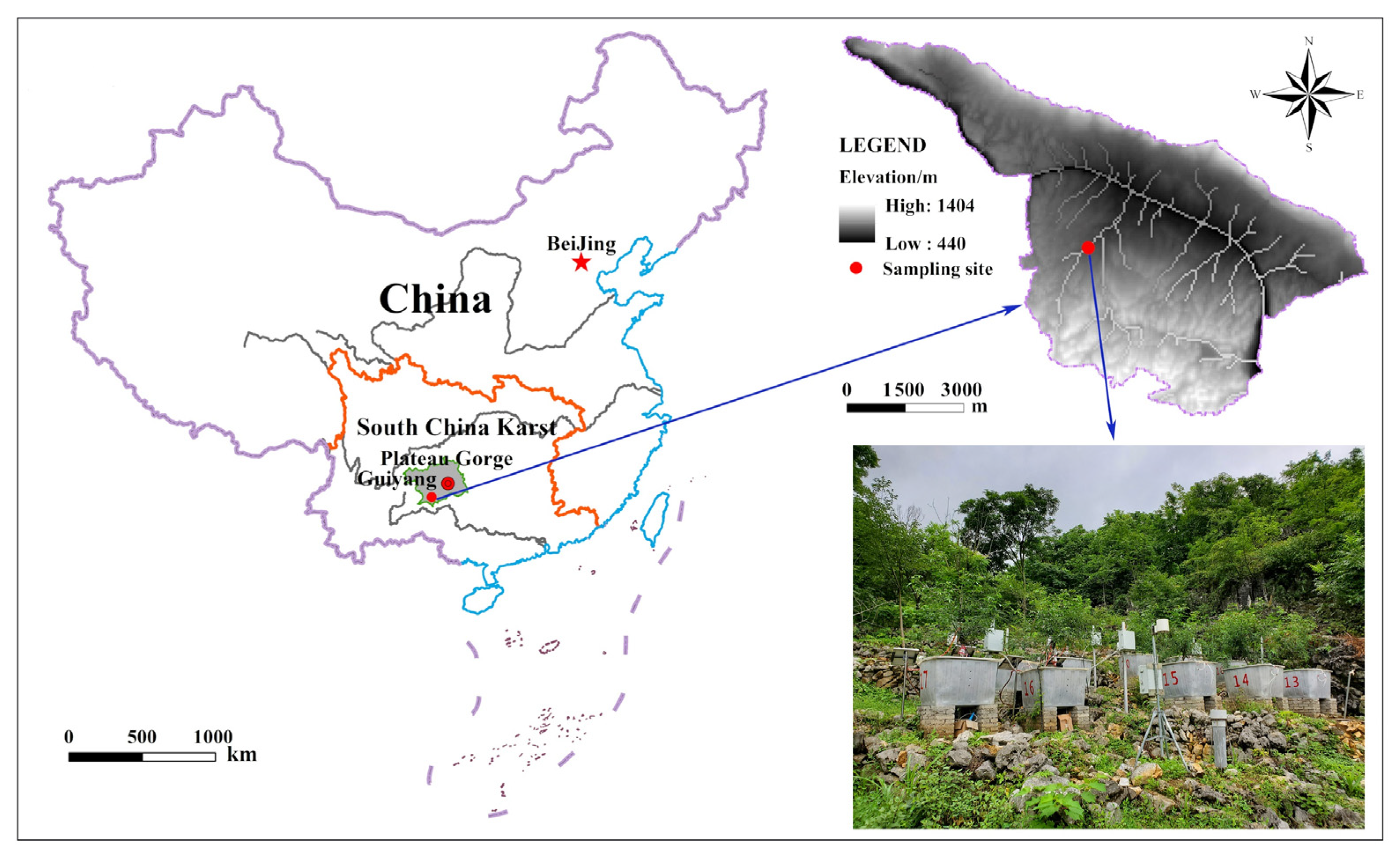

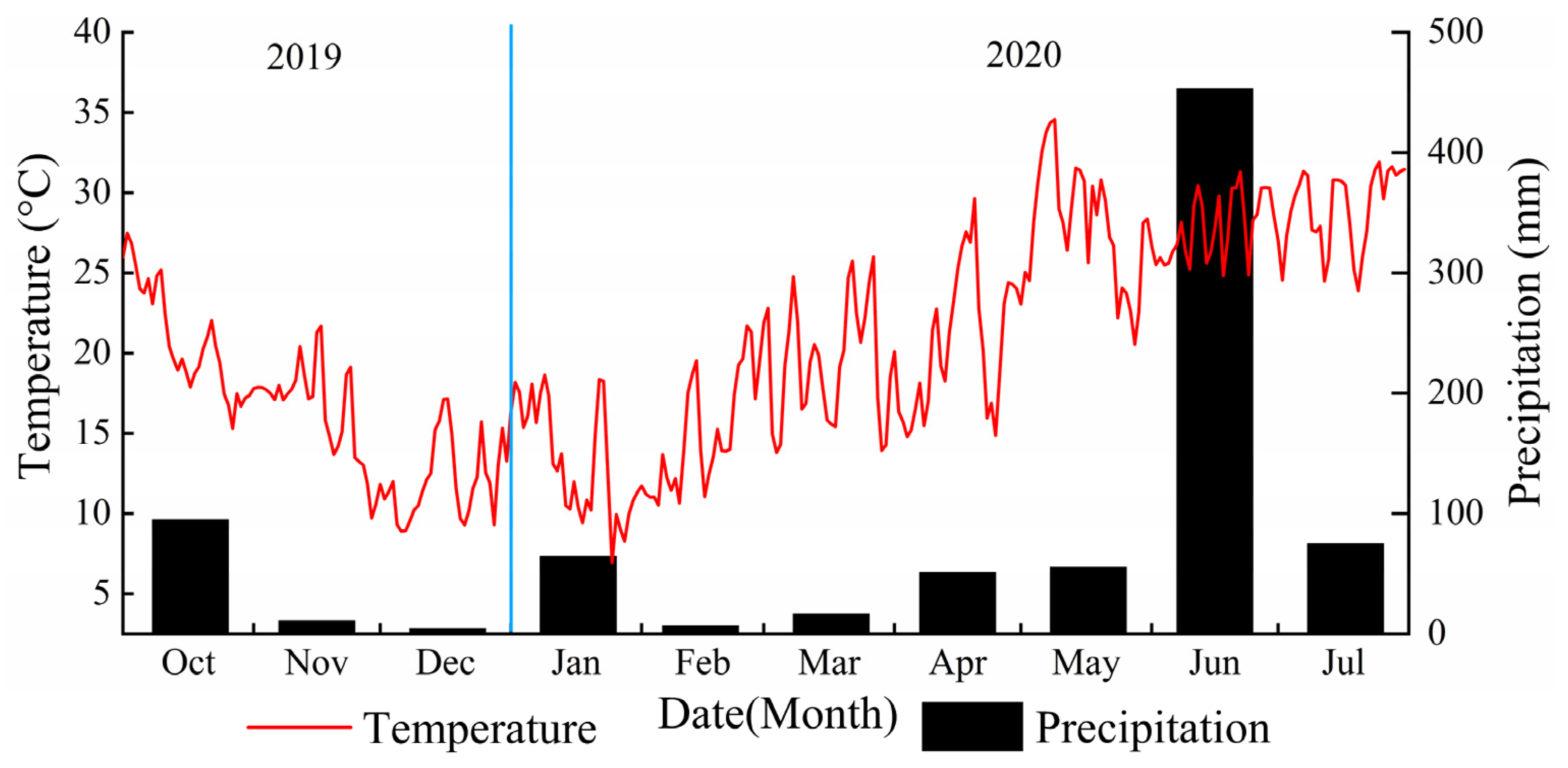
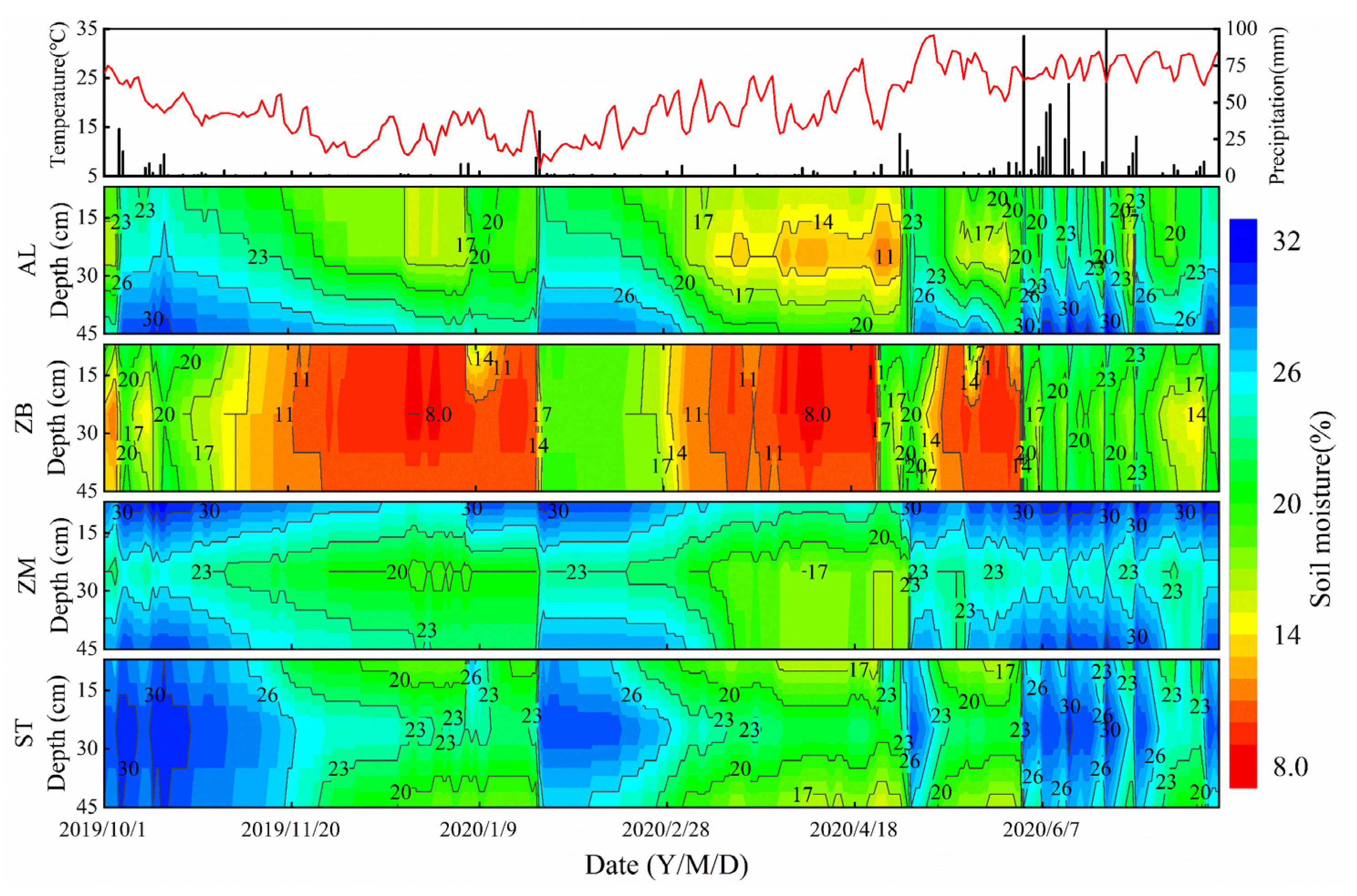
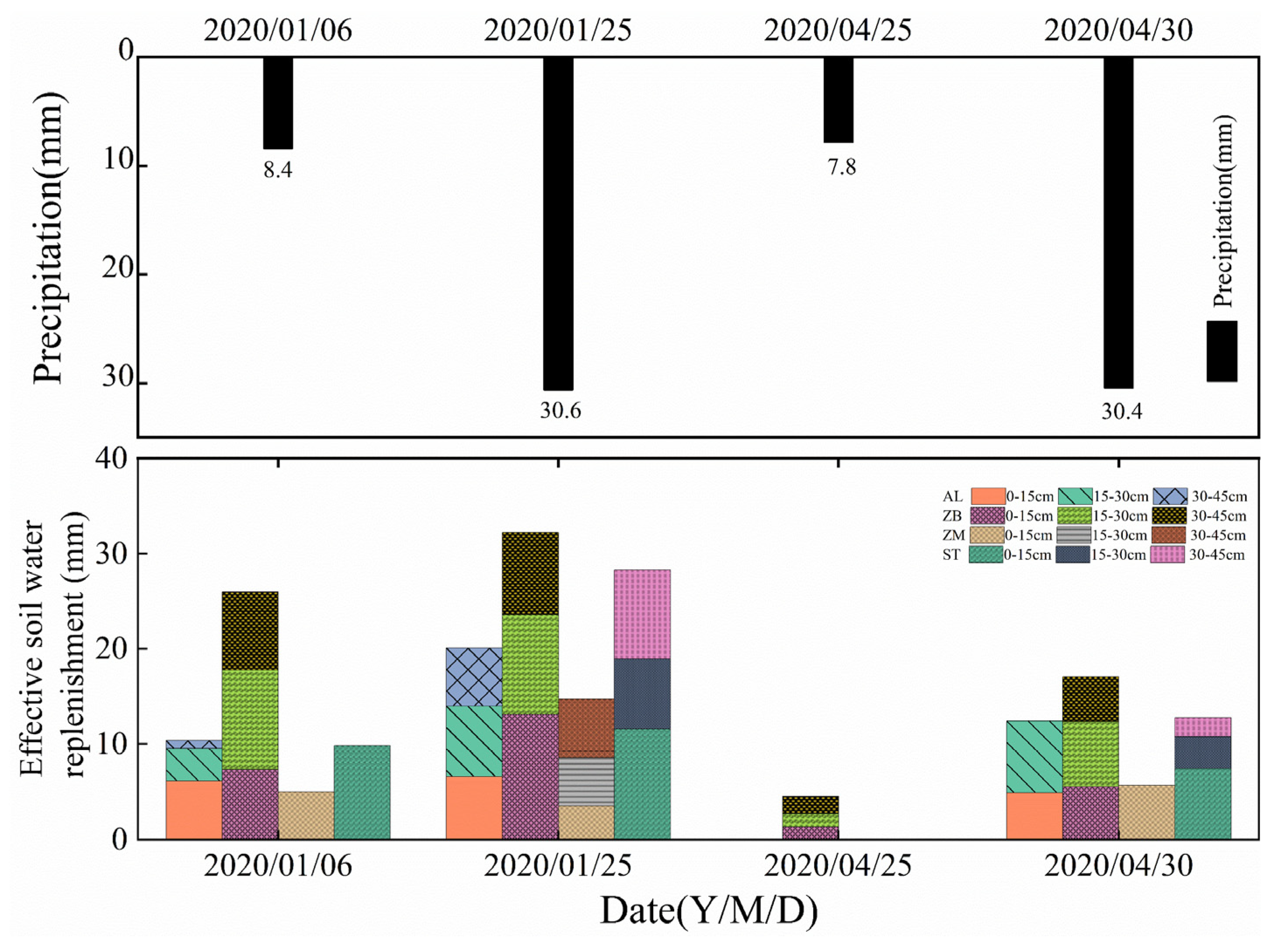



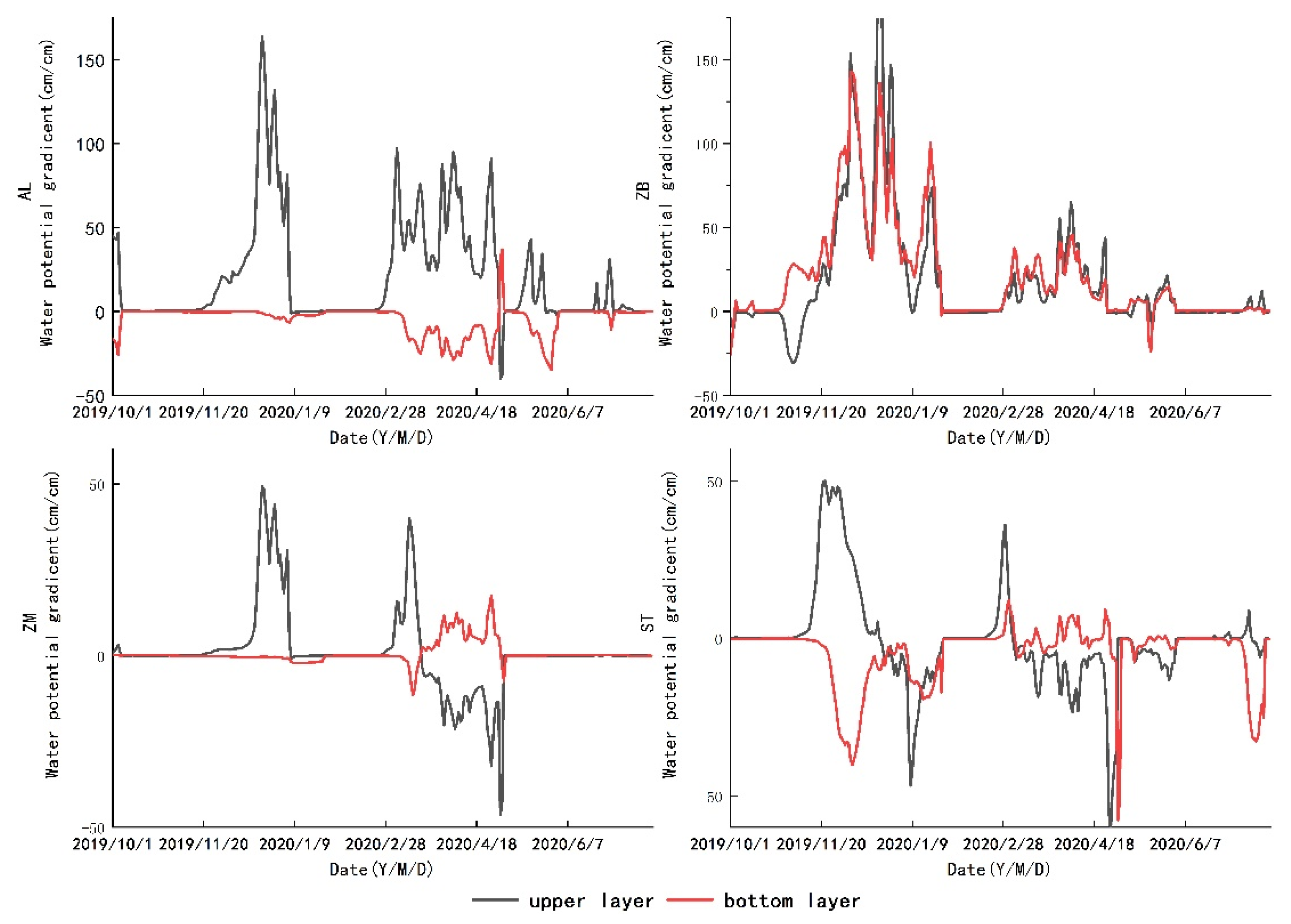
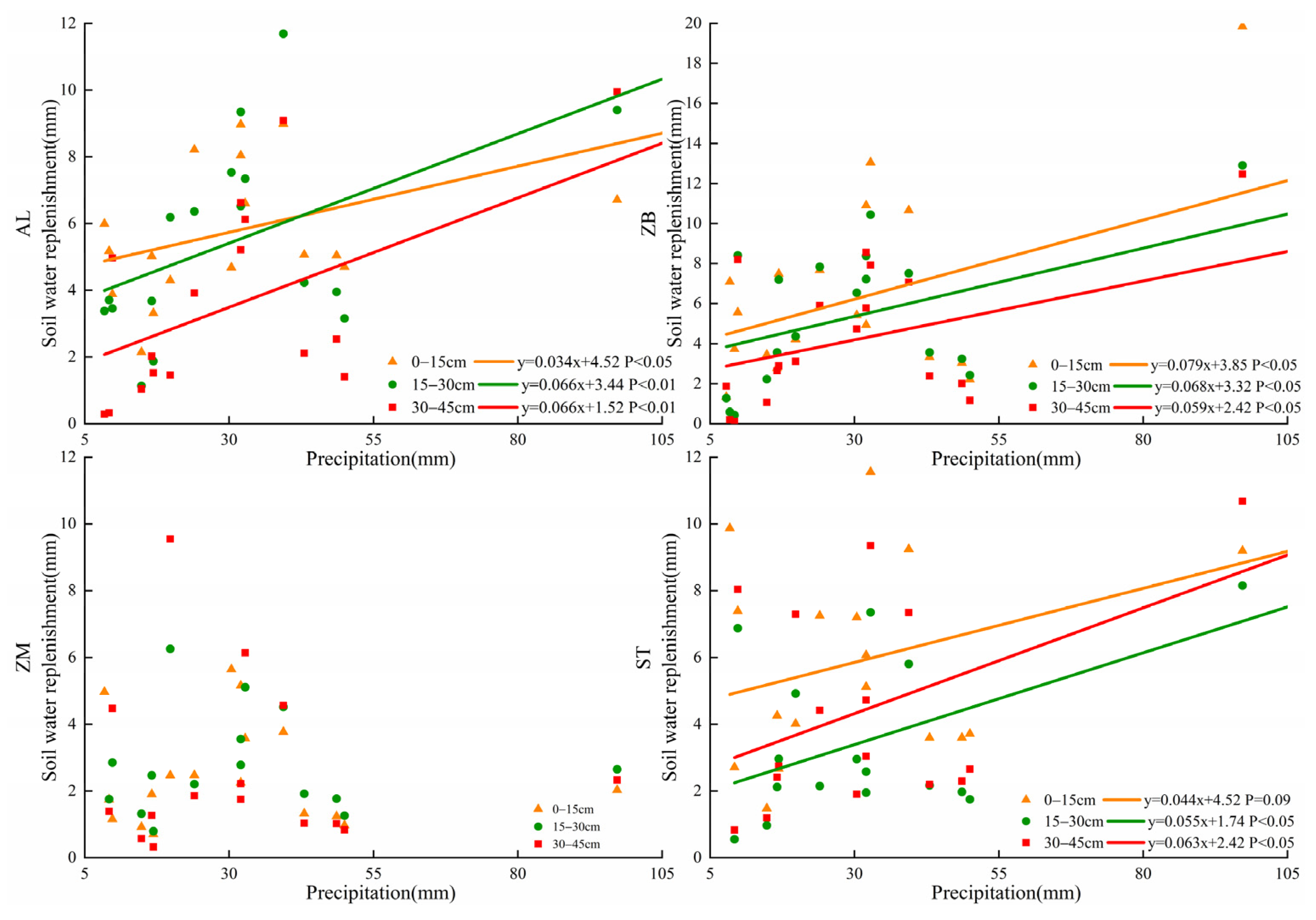
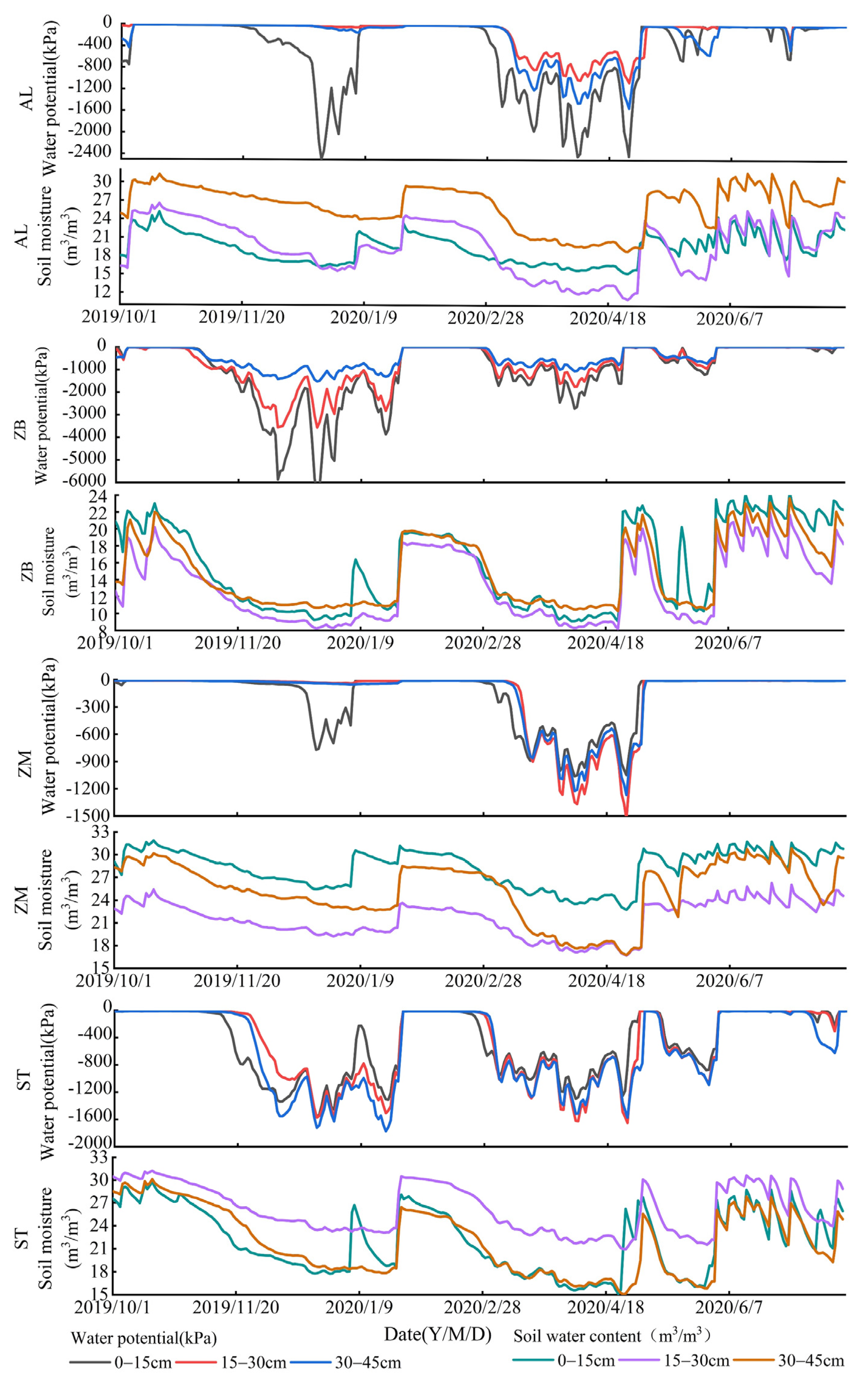
| Vegetation Types | Soil Depth (cm) | ρb (g/cm3) | FC (%) | CP (%) | NCP (%) | Ks (mm/min) |
|---|---|---|---|---|---|---|
| AL | 0–15 | 1.24 | 24.16 | 28.75 | 24.42 | 7.38 |
| 15–30 | 1.40 | 28.29 | 29.08 | 18.54 | 5.60 | |
| 30–45 | 1.51 | 33.52 | 30.44 | 13.62 | 3.88 | |
| ZB | 0–15 | 1.25 | 27.72 | 27.39 | 25.37 | 5.72 |
| 15–30 | 1.13 | 24.98 | 28.41 | 28.36 | 13.88 | |
| 30–45 | 1.28 | 26.32 | 25.24 | 26.54 | 1.57 | |
| ZM | 0–15 | 1.17 | 33.36 | 33.18 | 22.09 | 4.96 |
| 15–30 | 1.38 | 26.12 | 26.56 | 21.70 | 3.88 | |
| 30–45 | 1.53 | 29.30 | 27.20 | 16.39 | 2.33 | |
| ST | 0–15 | 1.24 | 26.31 | 31.34 | 21.59 | 8.24 |
| 15–30 | 1.33 | 32.00 | 33.72 | 16.33 | 6.50 | |
| 30–45 | 1.21 | 29.17 | 30.84 | 23.19 | 5.30 |
| Vegetation Types | Soil Depth (cm) | Soil Moisture | ||||
|---|---|---|---|---|---|---|
| MIN (%) | MAX (%) | Mean (%) | SD (%) | CV (%) | ||
| AL | 0–15 | 15.40 | 25.30 | 19.40 | 2.48 | 12.76 |
| 15–30 | 11.00 | 27.60 | 19.54 | 4.27 | 21.84 | |
| 30–45 | 19.00 | 32.70 | 26.25 | 3.46 | 13.18 | |
| mean | 15.03 | 28.53 | 21.73 | 3.40 | 15.93 | |
| ZB | 0–15 | 9.10 | 24.03 | 15.69 | 5.02 | 32.00 |
| 15–30 | 8.20 | 22.30 | 13.26 | 4.12 | 31.07 | |
| 30–45 | 10.30 | 24.10 | 14.96 | 4.07 | 27.23 | |
| mean | 9.20 | 23.57 | 14.64 | 4.40 | 30.10 | |
| ZM | 0–15 | 23.10 | 32.40 | 28.31 | 2.40 | 8.48 |
| 15–30 | 17.30 | 26.80 | 21.60 | 2.35 | 10.90 | |
| 30–45 | 17.60 | 31.40 | 25.35 | 3.81 | 15.04 | |
| mean | 19.33 | 30.20 | 25.09 | 2.86 | 11.47 | |
| ST | 0–15 | 15.10 | 29.80 | 22.06 | 4.19 | 19.01 |
| 15–30 | 20.90 | 31.20 | 26.16 | 3.13 | 11.98 | |
| 30–45 | 15.10 | 30.10 | 21.90 | 4.29 | 19.60 | |
| mean | 17.03 | 30.37 | 23.37 | 3.87 | 16.86 | |
| Date | Precipitation (mm) | AL | ZB | ZM | ST | ||||||||
|---|---|---|---|---|---|---|---|---|---|---|---|---|---|
| ∆SW | V (mm/h) | R (%) | ∆SW | V (mm/h) | R (%) | ∆SW | V (mm/h) | R (%) | ∆SW | V (mm/h) | R (%) | ||
| 5 October 2019 | 32.00 | 23.60 | 4.29 | 73.75 | 19.10 | 1.01 | 59.69 | 10.23 | 1.86 | 31.98 | 10.10 | 3.37 | 31.56 |
| 6 January 2020 | 8.40 | 6.88 | 0.32 | 81.90 | 6.24 | 0.32 | 74.29 | 4.24 | 0.20 | 50.48 | 7.12 | 0.79 | 84.76 |
| 25 January 2020 | 30.60 | 15.84 | 2.26 | 51.76 | 21.84 | 1.90 | 71.37 | 11.68 | 1.17 | 38.17 | 22.24 | 2.22 | 72.68 |
| 30 April 2020 | 30.40 | 12.30 | 1.29 | 40.46 | 15.20 | 3.80 | 50.00 | 5.30 | 0.28 | 17.43 | 9.50 | 0.59 | 31.25 |
| 2 June 2020 | 97.20 | 26.00 | 13.00 | 26.75 | 40.71 | 9.05 | 41.88 | 7.00 | 3.50 | 7.20 | 28.00 | 7.00 | 28.81 |
| 8 June 2020 | 43.00 | 10.40 | 4.16 | 24.19 | 9.30 | 1.86 | 21.63 | 4.30 | 1.08 | 10.00 | 6.90 | 1.73 | 16.05 |
| 25 June 2020 | 101.00 | 26.90 | 17.93 | 26.63 | 20.90 | 6.97 | 20.69 | 11.20 | 4.48 | 11.09 | 20.30 | 10.15 | 20.10 |
| 1 July 2020 | 42.40 | 29.10 | 2.08 | 68.63 | 25.00 | 3.85 | 58.96 | 12.90 | 1.84 | 30.42 | 22.50 | 3.46 | 53.07 |
| mean | 48.13 | 18.88 | 5.67 | 49.26 | 19.79 | 3.59 | 49.81 | 8.36 | 1.80 | 24.60 | 15.83 | 3.66 | 42.28 |
Publisher’s Note: MDPI stays neutral with regard to jurisdictional claims in published maps and institutional affiliations. |
© 2021 by the authors. Licensee MDPI, Basel, Switzerland. This article is an open access article distributed under the terms and conditions of the Creative Commons Attribution (CC BY) license (https://creativecommons.org/licenses/by/4.0/).
Share and Cite
Liu, Z.; She, R.; Xiong, K.; Li, Y.; Cai, L. Effect of Vegetation Restoration on Soil Hydrology in Karst Area of Southwest China: Inspiration from Barrel Planting Experiments. Water 2021, 13, 1719. https://doi.org/10.3390/w13131719
Liu Z, She R, Xiong K, Li Y, Cai L. Effect of Vegetation Restoration on Soil Hydrology in Karst Area of Southwest China: Inspiration from Barrel Planting Experiments. Water. 2021; 13(13):1719. https://doi.org/10.3390/w13131719
Chicago/Turabian StyleLiu, Ziqi, Rong She, Kangning Xiong, Yuan Li, and Lulu Cai. 2021. "Effect of Vegetation Restoration on Soil Hydrology in Karst Area of Southwest China: Inspiration from Barrel Planting Experiments" Water 13, no. 13: 1719. https://doi.org/10.3390/w13131719






